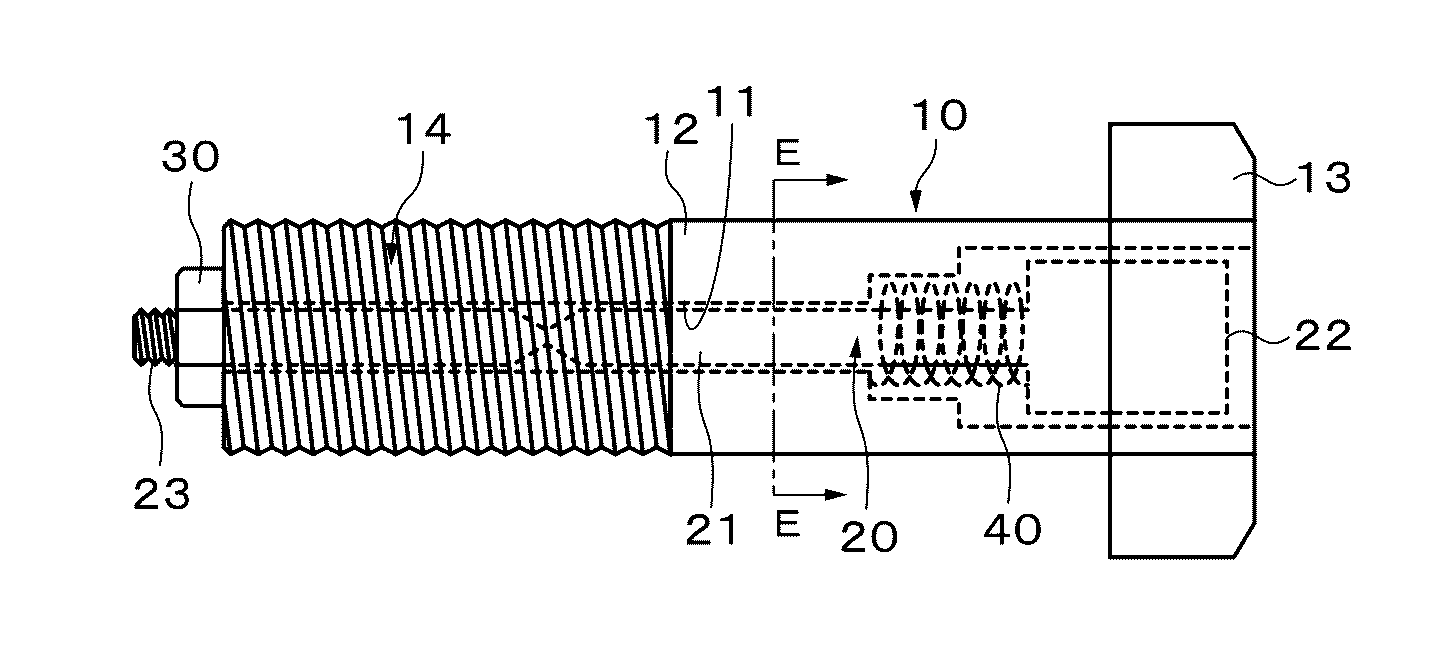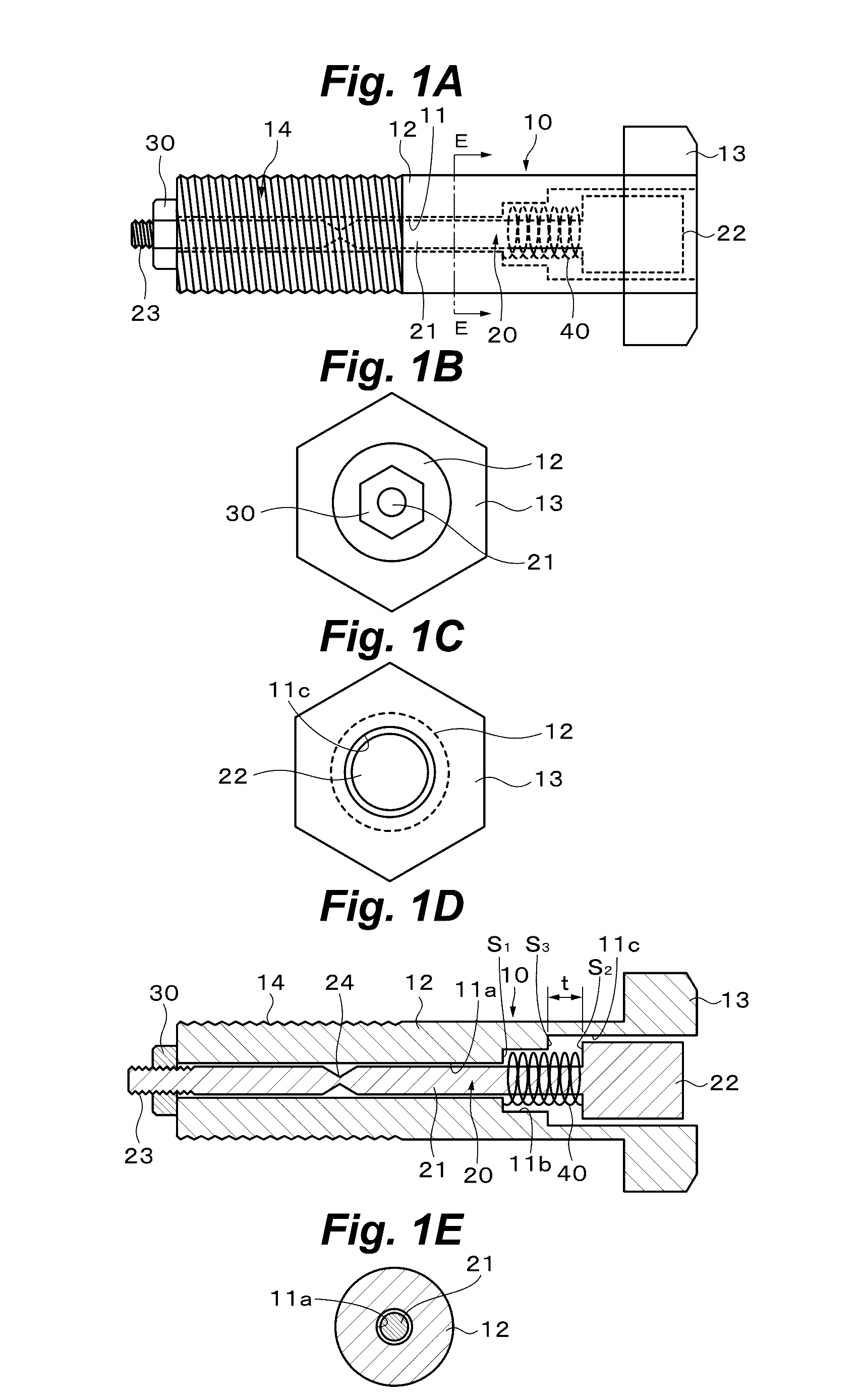Failure detection sensor, failure detection system, and structure
a failure detection system and sensor technology, applied in the direction of screws, load-modified fasteners, fastening means, etc., can solve the problems of torsional fracture and bend fracture, and achieve the effect of simple structure, easy detection of fracture signals, and short tim
- Summary
- Abstract
- Description
- Claims
- Application Information
AI Technical Summary
Benefits of technology
Problems solved by technology
Method used
Image
Examples
first embodiment
1. The First Embodiment
Failure Detection Sensor
[0130]FIG. 1A, FIG. 1B, FIG. 1C, FIG. 1D and FIG. 1E show the failure detection sensor according to the first embodiment, where FIG. 1A is a front view, FIG. 1B is a left side view, FIG. 1C is a right side view, FIG. 1D is a longitudinal cross sectional view and FIG. 1E is a cross sectional view along the E-E line of FIG. 1A. The failure detection sensor is especially suitable for detection of tensile fracture.
[0131]As shown in FIG. 1A, FIG. 1B, FIG. 1C, FIG. 1D and FIG. 1E, the failure detection sensor comprises a hexagonal bolt-like first member 10 with a hollow part 11 and a circular rod-like second member 20 which is inserted into the hollow part 11 of the first member 10. The second member 20 has fracturing characteristics such that it fractures during elastic deformation or plastic deformation of the first member 10.
[0132]FIG. 2A shows details of the first member 10, and FIG. 2B shows details of the second member 20. The total len...
second embodiment
2. The Second Embodiment
Failure Detection Sensor
[0145]FIG. 8A, FIG. 8B, FIG. 8C, FIG. 8D and FIG. 8E show the failure detection sensor according to the second embodiment, where FIG. 8A is a front view, FIG. 8B is a left side view, FIG. 8C is a right side view, FIG. 8D is a longitudinal cross sectional view and FIG. 8E is a cross sectional view along the E-E line of FIG. 8A. FIG. 9A shows details of the first member 10, and FIG. 9B shows details of the second member 20.
[0146]As shown in FIG. 8A, FIG. 8B, FIG. 8C, FIG. 8D, FIG. 8E, FIG. 9A and FIG. 9B, in the failure detection sensor, a female screw 15 is cut on the inner peripheral surface of the hollow part 11 of the axial part 12 of the first member 10 over a length L5 from the front end of the axial part 12. The male screw 23 is cut on the outer peripheral surface of the axial part 21 of the second member 20 over the length l3 from the front end of the axial part 21 larger than that of the first embodiment. And the male screw 23 o...
third embodiment
3. The Third Embodiment
Failure Detection Sensor
[0149]In the failure detection sensor according to the third embodiment, the nut 30 fitted to the male screw 23 of the axial part 21 of the second member 20 is fixed to the front part of the first member 10 by welding, gluing, brazing, etc. With this, the front part of the second member 20 is fixed to the front part of the first member 10.
[0150]Other than the above of the failure detection sensor is the same as the failure detection sensor according to the first embodiment.
[0151]According to the third embodiment, the same advantages as the first embodiment can be obtained.
PUM
| Property | Measurement | Unit |
|---|---|---|
| thickness | aaaaa | aaaaa |
| diameter | aaaaa | aaaaa |
| length | aaaaa | aaaaa |
Abstract
Description
Claims
Application Information
 Login to View More
Login to View More - R&D
- Intellectual Property
- Life Sciences
- Materials
- Tech Scout
- Unparalleled Data Quality
- Higher Quality Content
- 60% Fewer Hallucinations
Browse by: Latest US Patents, China's latest patents, Technical Efficacy Thesaurus, Application Domain, Technology Topic, Popular Technical Reports.
© 2025 PatSnap. All rights reserved.Legal|Privacy policy|Modern Slavery Act Transparency Statement|Sitemap|About US| Contact US: help@patsnap.com



